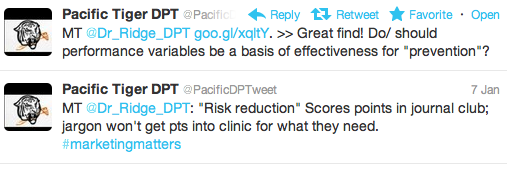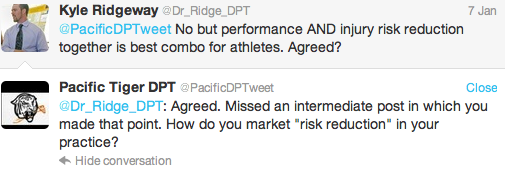Recently, I stumbled upon a website post via Twitter:

I absolutely love the basis and intent of the tweet! Female athletes exhibit increased incidence of non-contact anterior cruciate ligament injuries, so we need to work to reduce their risk of injury through specific training, performance, and post-surgical rehabilitation programs. ACL injury, reconstructive surgery, co-morbidities, rehabilitation, return to sport, and prevention all are hot topics currently. Studies have investigated risk factors for ACL injury, sport specific rehabilitation and return to play, accelerated vs. standard rehabilitation timeframes, as well as predictors of osteoarthritis following reconstruction. Some investigations attempt to identify individuals who can cope without an ACL vs. those who require surgical intervention. And unfortunately, as ACL injuries occur in younger and younger athletes physical therapists must consider the proper management of ACL injuries in skeletally immature individuals. I posted about fear of re-injury and return to sport following ACL reconstruction.
The link in the tweet is a Santa Monica Sports Medicine Foundation website page that explains the Prevent Injury and Enhance Performance (PEP) Program. But, I had 2 discussion points:
- The PEP may not be the best program
- Prevention may not be the best wording
Based upon my understanding of the literature on the topic, Sportsmetrics seems a superior choice for both injury risk reduction and performance. Second, I do not think we can truly and absolutely prevent injuries. Injury is an inherent risk of sport. Even non-contact ACL injuries are not totally preventable. Now, injury risk reduction is possible and feasible. I believe that the using the term prevention is the wrong nomenclature. It conveys an inaccurate message. Every attempt is made to reduce the relative risk of injury. But, make no mistake, there is no way to totally abolish injury risk. Maybe I am being too fussy…
In a strike of happy coincidence I read the abstract of a systematic review from the journal Sports Health: A Multi-disciplinary Approach the day before through Google Reader. The title of the article is Anterior Cruciate Ligament Injury Prevention Training In Female Athletes: A Systematic Review of Injury Reduction and Results of Athletic Performance Tests. The review analyzed the results of other studies in an attempt to ascertain which training programs decreased ACL injury risk and in conjunction what measures of performance were improved. The conclusion:
Sportsmetrics produced significant increases in lower extremity and abdominal strength, vertical jump height, estimated maximal aerobic power, speed, and agility. Prevent Injury and Enhance Performance (PEP) significantly improved isokinetic knee flexion strength but did not improve vertical jump height, speed, or agility. The other 3 programs (Myklebust, the “11,” and Knee Ligament Injury Prevention) did not improve both ACL injury rates and athletic performance tests.





@PacificTigerDPT brought up some excellent points in our exchange. The importance of marketing to patients and clients to maximize accessing the most effective care was something I did not think about. I really enjoyed conversing, discussing, and learning via Twitter.
Now, I am bias, because my practice location utilizes the Sportsmetrics program. I am most comfortable and familiar with administering Sportsmetrics. But, given the data in the above systematic review, I think Sportsmetrics is overall a superior program. Obviously, you want your injury risk reduction program to reduce the risk of injury! That is priority number one. But, improving performance measures such as power, aerobic capacity, strength, and agility is always at the forefront of any training, recovering, or rehabilitating athlete’s mind. In this regard, the data seems to suggest that Sportsmetrics outperforms Prevent Injury and Enhance Performance (PEP) Program. I would argue the Enhance Performance part of the name should be taken out, given the data shows that it only improves isokinetic knee flexion strength, but no measures of athletic performance.
The interactions on this topic I had through twitter as well as this resulting blog post are a real illustration of how to leverage Twitter, tweet replies, RSS feeds, and blog posts to engage in the analysis of literature, discussion of clinical practice, and comparison of research. I think this is the future of professional discussion, and potentially continuing education.
I was able to engage information from a tweet with replies. I read a website post on the PEP and compared it to the abstract I had read through RSS and Google Reader. Then, replied to the tweet with some of my analyses and a link to the systematic review. Lastly, I expanded upon my thoughts and analysis through this blog post. As illustrated, current technological and social media tool are not mutually exclusively. They can be leveraged together to facilitate networking, discussion, and professional growth.


You had a great experience… but not all experiences will be as you outlined. Todd (@PacificDPTweet) is a good, rational guy.
For those of you who try to engage and learn, some tweeps are buttheads. Some tweeps have agendas. Some tweeps no matter what you do or how you approach them, the tweeps refuse to truly engage. Don’t get frustrated – do some self-reflecting to think if there was a better way for you to have engaged and if there wasn’t then it’s not your fault that some great discussion didn’t occur. Tweeps like that deserve the “unfollow” click. I’m sure you’ll be able to find another Tweep with just as much value along the same specialty who IS engaging.
Twitter is kind of like poker – you gotta know when to hold ’em and know when to fold ’em. Excellent example…. I just don’t want everyone to believe interchanges that you shared are so Twitter-perfect. You and Todd are top-notch without horrible egos, self-esteem issues or hidden agendas. You are both motivated to learn and share.
Excellent point Selena. Just as in the real world, not everyone is ready to debate rationally and productively.
Thank you for the compliment by the way 🙂
Nice post Kyle. I recently joined twitter (@joebrence9) and am still trying to learn the language. It seems to be a great tool in directing me to blogs and promoting mine. But that stated, my favorite line in this blog has nothing to do with leveraging technology but one you make on prevention: “Second, I do not think we can truly and absolutely prevent injuries. Injury is an inherent risk of sport. Even non-contact ACL injuries are not totally preventable.” This is so true.
Mike Reinold featured the leveraging technology series on his blog, and provided some additional insights. Thanks Mike!
http://www.mikereinold.com/2012/01/great-physical-therapy-resources-on-the-web.html#comment-4049
The Black Swan
http://www.ncbi.nlm.nih.gov/pmc/articles/PMC2887657/